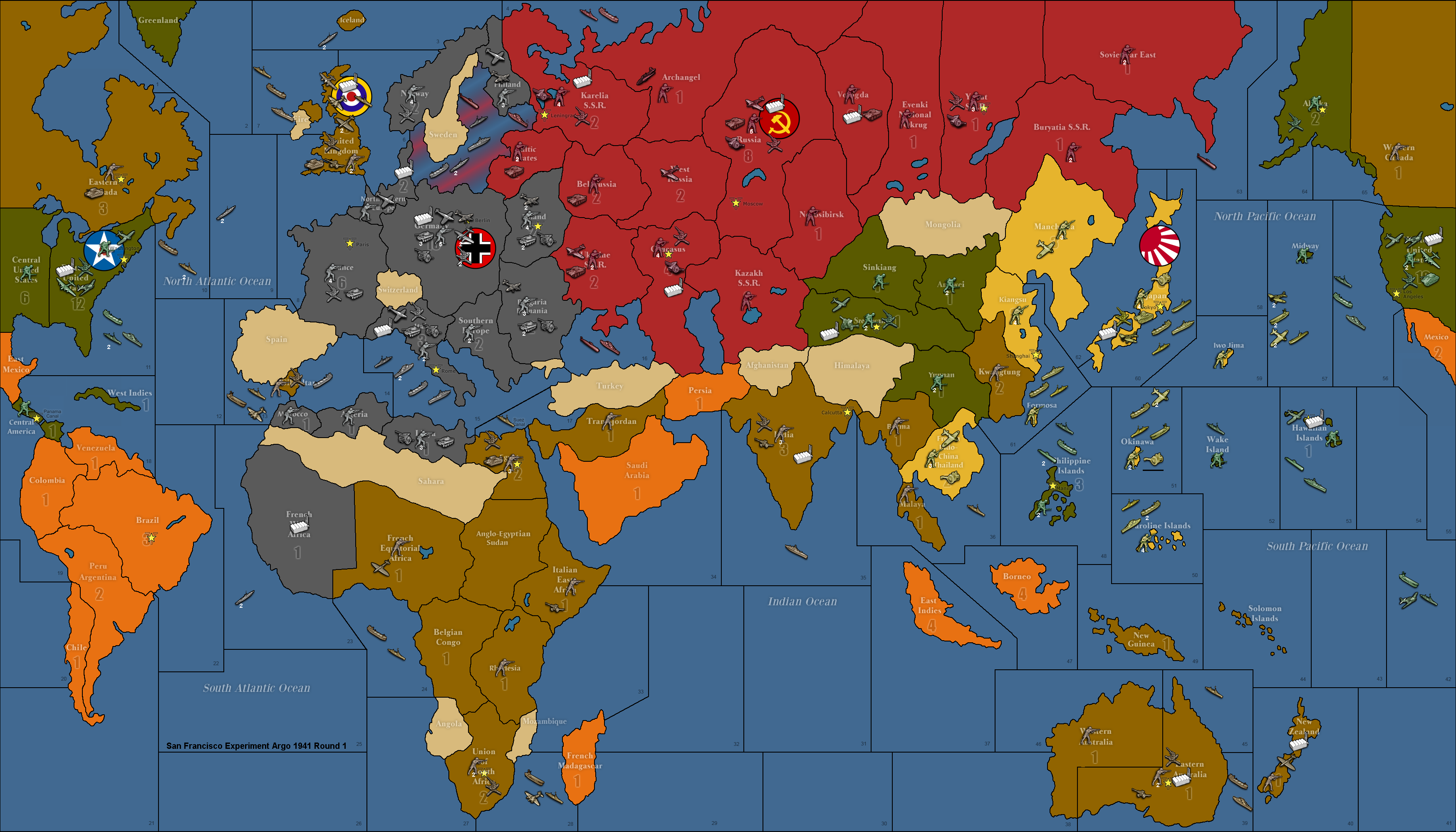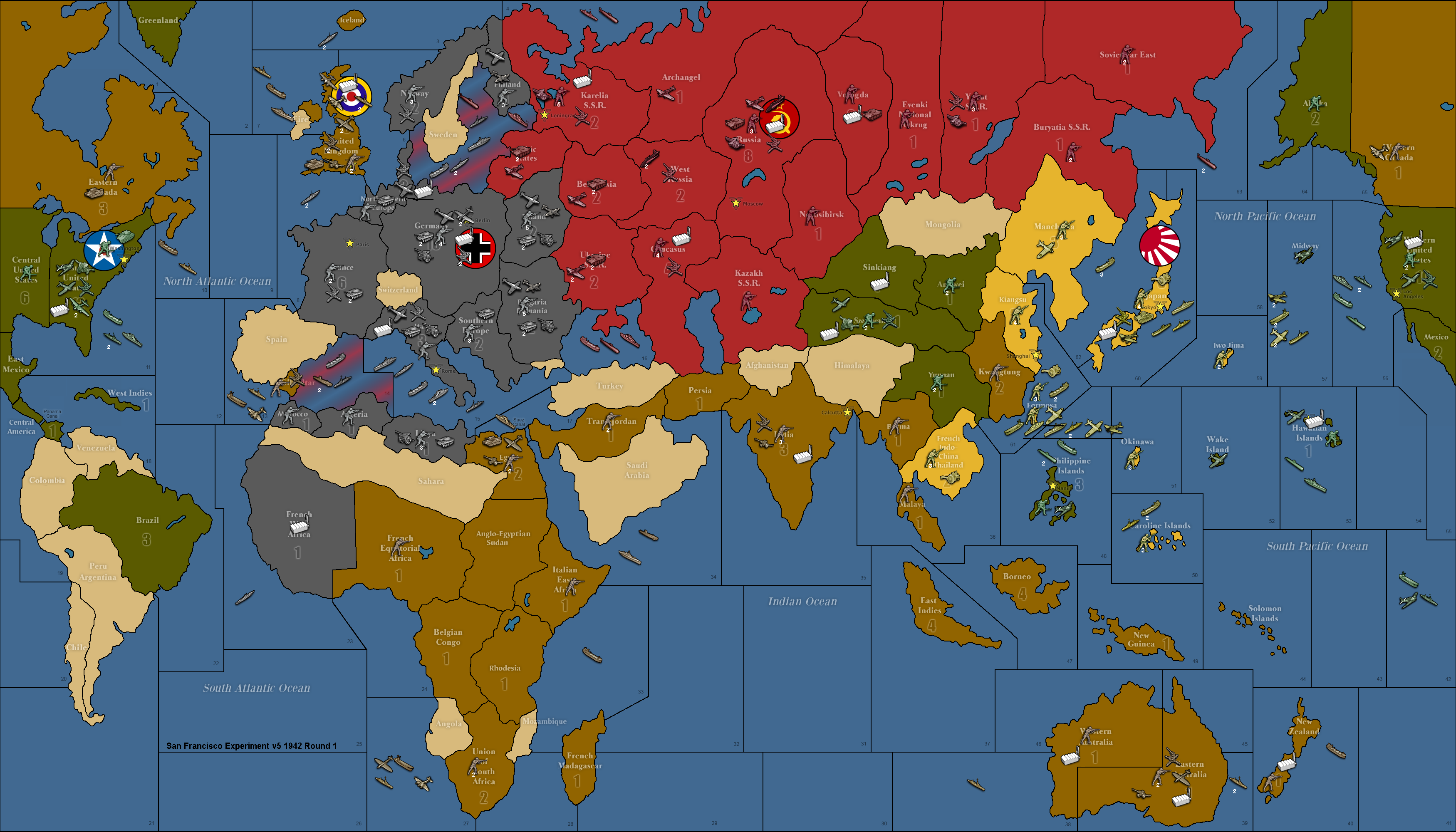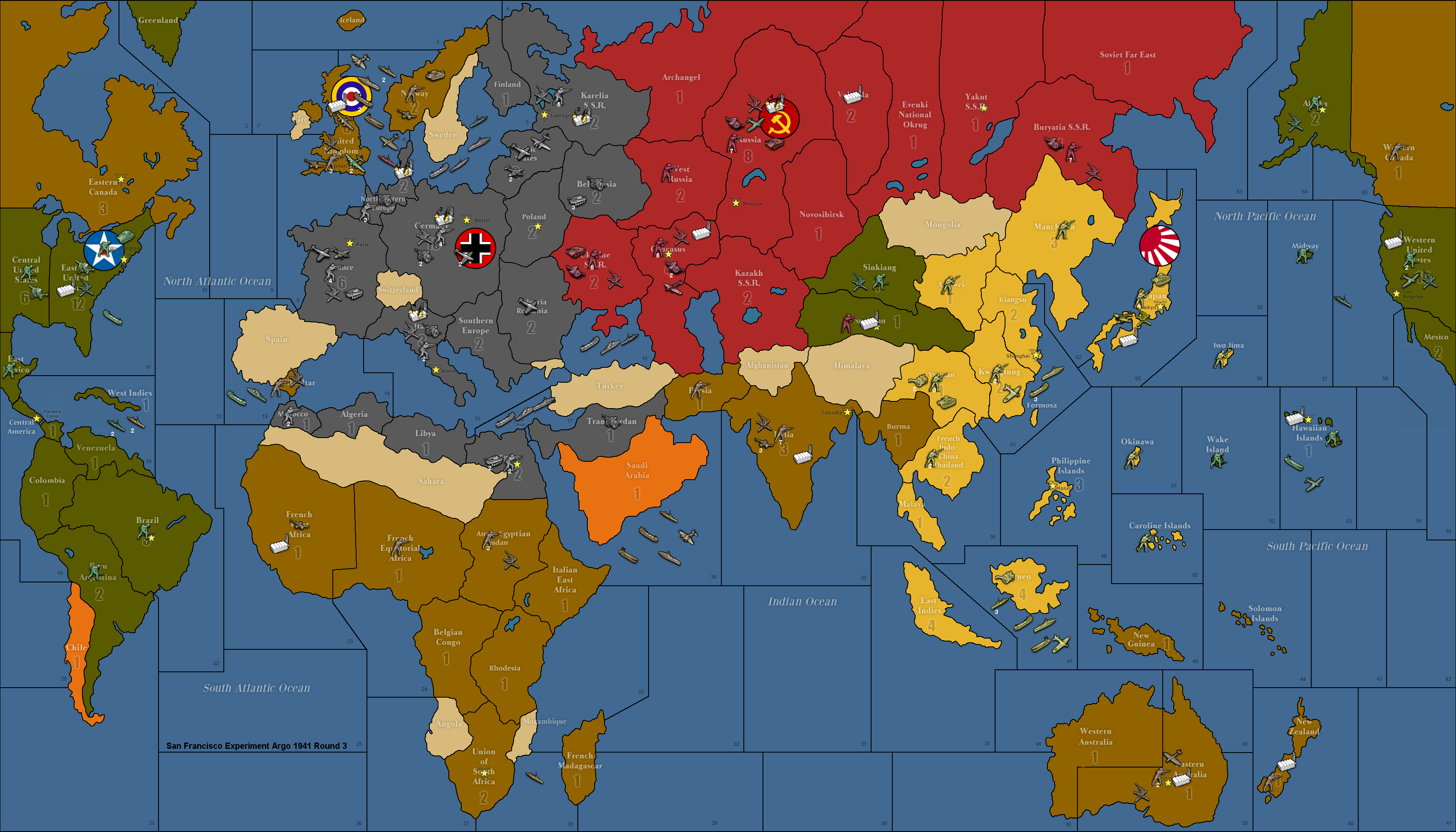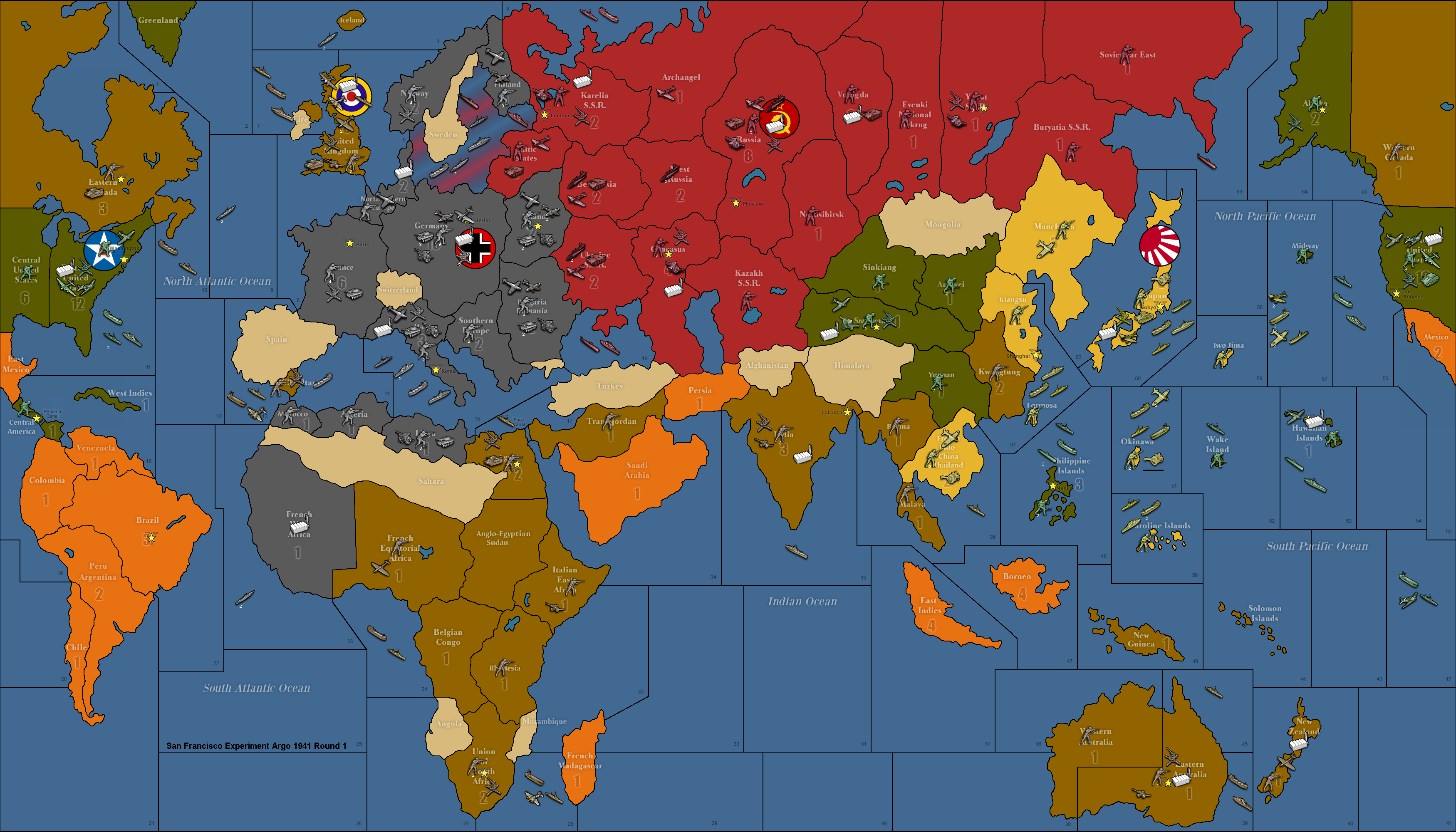1941 Redesign setup for A&A 1942.2 assuming M3 Cruiser and Transport
Tirpitz version 1.02
This Redesign set-up includes more warships ATO (8 Germans Subs), to be more historically accurate, or gives little more challenge in China, and add a lot of Tanks and aircrafts, a few Submarines, Cruiser and 1 Transport for Russia. Also, US PTO Islands received planes instead of Infantry while Japan received more Transports and Infantry on Iwo Jima and Okinawa to take care of these menaces.
At least, it provides a reason to invade these islands on J1.
Set up includes from San Francisco Experiment V5 1942.2:
Fighter A3 D4 M4 C10, A1 D1 in SBR escort and intercept, preemptive Anti-Sub Attack 1, Anti-Sub Defense 1
TcBs A3-4 D3 M4 C10 SBR A1 D6 damage, preemptive Anti-Sub Attack 1, Anti-Sub Defense 1
StBs A0 D0 M6 C5 D6 damage
Destroyer A1 D1 M2 C5, preemptive Anti-Sub Attack 1, Anti-Sub Defense 1
Transport and Cruiser can move up to 3 SZs.
Turn order is:
1-Germany
2-United Kingdom
3-Japan
4-USA
5-Soviet Union
Other Player-Enforced Rules
-
You must own Gibraltar to move anything except submarines between SZ 13 <-> SZ 14
-
You must own NW Europe to move anything except submarines between SZ 5 <-> SZ 6.
-
Dardanelles Strait (near Turkey) is open to all players.
-
The factories in Szechwan and Sinkiang produces only infantry or Artillery, and it is destroyed if captured by the Axis.
Also, considered Western Chinese border is impassable for land units from both sides.
On tabletop, you may decide to simply built 1 Infantry for each 2 IPCs from Chinese TTy (rounding up) instead of placing factories in China.
To be tested:
If you choose to move any type of surface ships through a sea zone containing one or more enemy submarines without stopping to fight those submarines, you must roll one die per enemy submarine (it does not matter how many ships you move, only how many enemy subs there are).
Your fleet takes one hit for each “1” rolled on the dice.
If you move through more than one sub-infested sea zone, repeat this process.
Argothair suggestion slightly modified.
Soviet Union
Starting income: 32 (24+ 8 ) IPCs
Russia: 3 Infantry, 1 Artillery, 1 AAA, 1 Tank, 1 Fighter, 1 Tactical Bomber, Industrial Complex
Karelia S.S.R.: 5 Infantry, 1 Artillery, 1 AAA, Industrial Complex
Archangel: 1 Fighter
Vologda: 1 Infantry, 1 Tank, Industrial Complex
Evenki National Okrug: 1 Infantry
Novosibirsk: 1 Infantry
Kazakh S.S.R.: 1 Infantry
Caucasus: 4 Infantry, 1 AAA, Industrial Complex
Yakut S.S.R.: 3 Infantry, 1 Artillery, 1 AAA
Buryatia S.S.R.: 2 Infantry
Soviet Far East: 2 Infantry
Baltic States (Russian): 2 Tanks, 1 Fighter
Belorussia (Russian): 2 Tanks, 1 Fighter
Ukraine S.S.R. (Russian): 2 Tanks, 2 Fighters
West Russia (Russian): 1 AAA, 2 Tactical Bombers
Naval Setup:
Sea Zone 4: 1 Submarine, 1 Destroyer
Sea Zone 5 (Contested to Germany): 1 Cruiser, 1 Submarine
Sea Zone 16: 1 Cruiser, 1 Submarine, 1 Transport
Sea Zone 63: 2 Submarines
United Kingdom
Starting income: 42 (31+ 12-1) IPCs
United Kingdom: 2 Infantry, 1 Artillery, 2 AAAs, 1 Tank, 2 Fighters, 1 TacBomber, 1 Strategic Bomber, Industrial Complex
Eastern Canada: 1 Infantry, 1 Tank
Egypt: 2 Infantry, 1 Artillery, 1 Tank, 1 Fighter
Union of South Africa: 2 Infantry
Trans Jordan: 2 Infantry
India: 3 Infantry, 1 Artillery, 1 AAA, 1 Industrial Complex
Burma: 1 Infantry
Eastern Australia: 2 Infantry, 1 Artillery, 1 AAA, 1 Industrial Complex
Western Australia: 1 Infantry, 1 Industrial Complex
Western Canada: 1 Infantry, 1 TacBomber
New Zealand: 1 Infantry, 1 Industrial Complex
French Equatorial Africa: 1 Infantry
Italian East Africa: 1 Infantry
Kwangtung (United Kingdom): 1 Infantry
Malaya (United Kingdom): 1 Infantry
Persia : (United Kingdom)
East Indies: (United Kingdom)
Borneo: (United Kingdom)
New Guinea: (United Kingdom)
Solomon Islands: (United Kingdom)
Naval Setup:
Sea Zone 6: 2 Destroyers
Sea Zone 7: 1 Battleship, 1 Destroyer, 1 Transport
Sea Zone 10: 1 Destroyer, 1 Transport
Sea Zone 13: 1 Aircraft Carrier with 1 TacBomber, 1 Destroyer
Sea Zone 14 (Contested to Germany): 2 Submarines
Sea Zone 17: 1 Cruiser
Sea Zone 27: 1 Aircraft Carrier with 1 Fighter & 1 TacBomber, 1 Destroyer
Sea Zone 33: 1 Transport
Sea Zone 34: 1 Battleship, 1 Submarine
Sea Zone 38: 1 Destroyer
Sea Zone 39: 2 Destroyers
Sea Zone 40: 1 Transport
United States
Starting income: 45 (42+ 3) IPCs
Eastern United States: 2 Infantry, 1 Artillery, 1 AAA, 1 Tank, 1 Fighter, 1 TacBomber, 2 Strategic Bombers, Industrial Complex
Central United States: 1 Infantry
Alaska: 1 Infantry
Western United States: 2 Infantry, 1 AAA, 1 Fighter, 1 TacBomber, IC
Midway: 1 Tactical Bomber
Hawaiian Islands: 1 Infantry, 1 Fighter, 1 Industrial Complex
Yunnan: 2 Infantry
Szechwan: 2 Infantry, 1 Artillery, 1 AAA, 1 Fighter
(IC for chinese purpose only, destroyed once captured: built Infantry or Artillery only)
Anhwei: 2 Infantry
Sinkiang: (IC for chinese purpose only, destroyed once captured: built Infantry or Artillery only)
Wake Island (United States): 1 Fighter
Philippine Islands (United States): 1 Infantry, 1 Tactical Bomber
Naval Setup:
Sea Zone 11: 1 Cruiser, 2 Destroyers, 1 Transport
Sea Zone 42: 1 Aircraft Carrier with 1 TacBomber, 1 Destroyer
Sea Zone 48: 2 Submarines, 1 Transport
Sea Zone 53: 1 Battleship, 1 Submarine
Sea Zone 56: 1 Cruiser, 1 Submarine, 2 Destroyers, 1 Transport
Germany
Starting income: 34 (41- 8+1 ) IPCs
Germany: 4 Infantry, 1 Artillery, 2 AAAs, 2 Tanks, 1 Fighter, 2 Strategic Bombers, 1 Industrial Complex
France: 2 Infantry, 1 AAA, 2 Tanks
Northwestern Europe: 1 Infantry, 1 AAA, 1 Tank, 1 Fighter, 1 Industrial Complex
Norway: 3 Infantry, 1 AAA
Finland: 3 Infantry, 1 Fighter, 1 TacBomber
Poland: 5 Infantry, 1 Artillery, 2 Tanks, 1 Fighter, 1 TacBomber
Bulgaria Romania: 5 Infantry, 1 Artillery, 2 Tanks, 1 Fighter, 1 TacBomber
Italy: 1 Infantry, 1 Artillery, 1 AAA, 1 Tank, 1 Fighter, 1 Industrial Complex
Southern Europe: 3 Infantry, 1 Tank
Morocco: 1 Infantry
Libya: 3 Infantry, 1 Artillery, 1 Tank
Algeria: 1 Infantry
French Western Africa (Vichy): Industrial Complex
Naval Setup:
Sea Zone 5: 1 Battleship, 2 Submarines, 1 Destroyer, 1 Transport
Sea Zone 8: 2 Submarines
Sea Zone 3: 2 Submarines
Sea Zone 14: 1 Destroyer, 1 Transport
Sea Zone 15: 1 Battleship, 2 Cruisers, 1 Submarine, 1 Destroyer, 1 Transport
Sea Zone 23: 1 Submarine
Japan
Starting income: 15 (30 - 15) IPCs
Japan: 4 Infantry, 1 Artillery, 1 AAA, 1 Tank, 1 Tactical Bomber, 1 Industrial Complex
Manchuria: 3 Infantry, 1 Fighter
Kiangsu: 4 Infantry
Iwo Jima: 2 Infantry
Okinawa: 3 Infantry
Caroline Islands: 3 Infantry
Formosa: 1 Infantry, 1 Fighter
French Indo-China Thailand: 3 Infantry, 1 Artillery
Naval Setup:
Sea Zone 57: 2 Aircraft Carriers, 1 Submarine, 2 Fighters, 2 TacBombers
Sea Zone 50: 1 Destroyer, 2 Transports
Sea Zone 60: 1 Battleship, 1 Submarine, 1 Destroyer
Sea Zone 61: 1 Aircraft Carrier with 1 Fighter & 1 TacBomber, 1 Battleship, 1 Cruiser, 2 Destroyers, 1 Transport with 1 Infantry & 1 Artillery, 1 Transport with 2 Infantry
Sea Zone 62: 3 Transports
1941REDESIGNGermany1_TirpitzV1.02.tsvg









